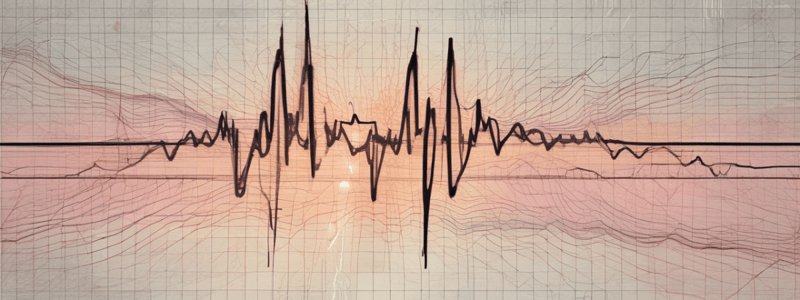Podcast
Questions and Answers
¿Qué aspecto del corazón se ve reflejado mediante la amplitud del complejo QRS en un EKG?
¿Qué aspecto del corazón se ve reflejado mediante la amplitud del complejo QRS en un EKG?
- Déficit de conducción ventricular
- Fibrosis miocárdica
- Arritmia supraventricular
- Hipertrofia ventricular (correct)
¿Qué es la conducción aberrante o aberrancia en relación con un EKG?
¿Qué es la conducción aberrante o aberrancia en relación con un EKG?
- Fibrilación auricular
- Bloqueo de rama ventricular (correct)
- Taquicardia supraventricular
- Taquicardia sinusal
¿Qué método de prueba especial se puede utilizar para identificar la conducción aberrante en un EKG estándar?
¿Qué método de prueba especial se puede utilizar para identificar la conducción aberrante en un EKG estándar?
- Electrocardiografía de Holter
- Estudio ecocardiográfico
- Prueba de esfuerzo
- Prueba de esfuerzo o estimulación eléctrica programada (correct)
¿Qué representa la amplitud del complejo QRS en un EKG?
¿Qué representa la amplitud del complejo QRS en un EKG?
¿Cuál de las siguientes condiciones puede causar una amplitud mayor del complejo QRS?
¿Cuál de las siguientes condiciones puede causar una amplitud mayor del complejo QRS?
¿Qué tipo de arritmia ventricular puede provocar la conducción aberrante?
¿Qué tipo de arritmia ventricular puede provocar la conducción aberrante?
¿Qué órgano se ve afectado por una anomalía en la conducción aberrante?
¿Qué órgano se ve afectado por una anomalía en la conducción aberrante?
¿Qué método especial puede ayudar a identificar la conducción aberrante en un paciente?
¿Qué método especial puede ayudar a identificar la conducción aberrante en un paciente?
¿Qué puede indicar amplitudes bajas de QRS en un paciente con colapso circulatorio?
¿Qué puede indicar amplitudes bajas de QRS en un paciente con colapso circulatorio?
¿Qué puede indicar tiempos prolongados del pico de onda R en el electrocardiograma?
¿Qué puede indicar tiempos prolongados del pico de onda R en el electrocardiograma?
¿En qué condiciones se puede observar que el tiempo del pico de onda R en las derivaciones laterales del EKG está prolongado?
¿En qué condiciones se puede observar que el tiempo del pico de onda R en las derivaciones laterales del EKG está prolongado?
¿Qué indicaría un QRS con amplitudes muy elevadas en un EKG?
¿Qué indicaría un QRS con amplitudes muy elevadas en un EKG?
¿Por qué es crucial entender la patología del EKG para la interpretación y manejo efectivo de pacientes cardíacos?
¿Por qué es crucial entender la patología del EKG para la interpretación y manejo efectivo de pacientes cardíacos?
¿Qué condiciones pueden estar asociadas con la prolongación del tiempo del pico de onda R en el EKG?
¿Qué condiciones pueden estar asociadas con la prolongación del tiempo del pico de onda R en el EKG?
¿Qué patología cardíaca puede causar amplias variaciones en la conducción ventricular en el EKG?
¿Qué patología cardíaca puede causar amplias variaciones en la conducción ventricular en el EKG?
Para un paciente con hipertiroidismo, ¿cuál de las siguientes anomalías del EKG podría ser esperada?
Para un paciente con hipertiroidismo, ¿cuál de las siguientes anomalías del EKG podría ser esperada?
¿Qué anormalidad en el EKG se asocia comúnmente con un infarto agudo de miocardio?
¿Qué anormalidad en el EKG se asocia comúnmente con un infarto agudo de miocardio?
Flashcards are hidden until you start studying
Study Notes
EKG Pathology
An electrocardiogram (EKG) is a diagnostic tool that measures the electrical activity of the heart. The EKG trace is used to identify abnormalities in the heart's electrical conduction system, which can be indicative of various cardiac conditions. This article will discuss the different aspects of EKG pathology, focusing on aberrant ventricular conduction, amplitude of the QRS complex, and R-wave peak time.
Aberrant Ventricular Conduction (Aberrancy)
Aberrant conduction, also known as aberrancy, is a type of ventricular arrhythmia that occurs when the heart's electrical conduction system fails to adapt to high heart rates. This can result in a bundle branch block, which is a delay or blockage in the conduction of electrical impulses within the heart. Aberrancy can cause a wide range of rhythm disturbances, including ventricular tachycardia and ventricular fibrillation, which can be life-threatening if not treated promptly. Aberrancy can be difficult to detect on a standard EKG, but special testing methods such as exercise testing or programmed electrical stimulation can help identify this condition.
Amplitude of the QRS Complex
The QRS complex in an EKG waveform represents ventricular depolarization. The amplitude of the QRS complex can be an indicator of ventricular hypertrophy or enlargement. Larger QRS complex amplitudes may be due to an increase in ventricular muscle mass, which can be seen in conditions such as hypertension or aortic stenosis. Conversely, low QRS amplitudes may be seen in patients with chronic obstructive pulmonary disease (COPD) or hypothyroidism. In the setting of circulatory collapse, low QRS amplitudes should raise suspicion of cardiac tamponade.
R-Wave Peak Time
The R-wave peak time is the time from the start of the QRS complex to the peak of the R wave in the EKG waveform. A normal R-wave peak time is typically less than 0.12 seconds. Prolonged R-wave peak times can indicate delayed ventricular depolarization, which can be seen in conditions such as right or left ventricular hypertrophy or myocardial ischemia. In the case of left ventricular hypertrophy, the R-wave peak time in the lateral leads (I, aVL, aVR, V5, V6) may be prolonged, while in the case of right ventricular hypertrophy, the R-wave peak time in the inferior leads (II, III, aVF) may be prolonged.
In conclusion, EKG pathology encompasses a wide range of abnormalities in the heart's electrical conduction system. Aberrant ventricular conduction, amplitude of the QRS complex, and R-wave peak time are just a few of the factors that can help diagnose and monitor various cardiac conditions. Understanding these aspects of EKG pathology is crucial for the accurate interpretation of EKGs and the effective management of cardiac patients.
Studying That Suits You
Use AI to generate personalized quizzes and flashcards to suit your learning preferences.




